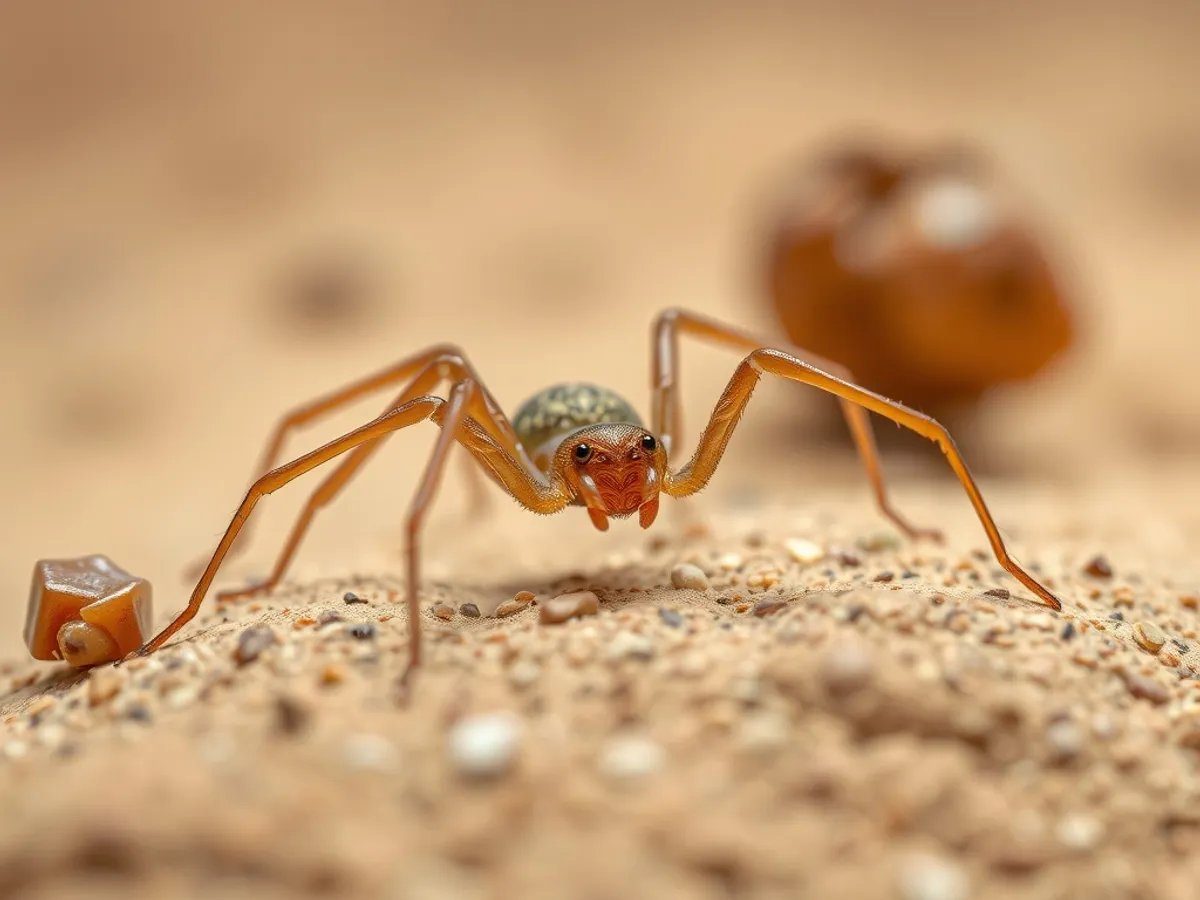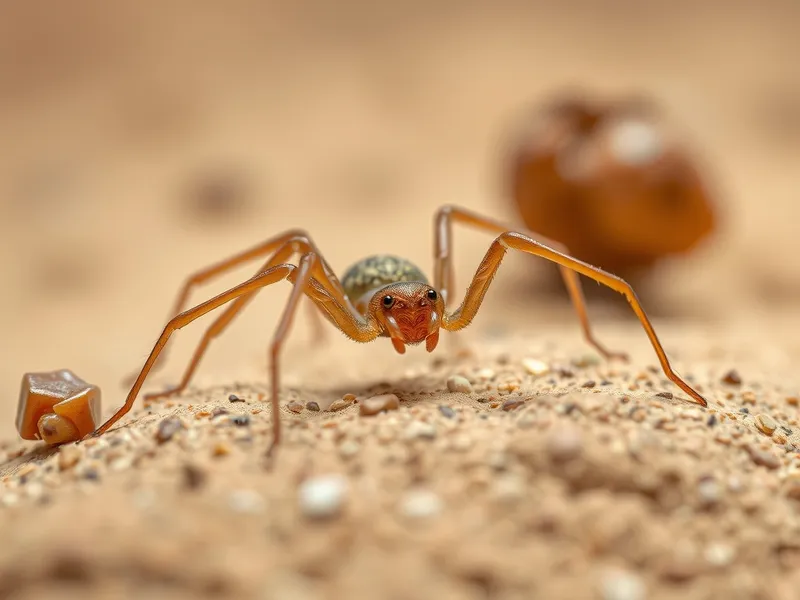
Camel Spider
Galeodes arabs

Meet the Camel Spider
The camel spider, also known as a wind scorpion or solifuge, is a fast-moving arachnid found in arid desert regions. Despite popular myths, camel spiders are not venomous to humans and do not prey on camels. They possess large, powerful chelicerae (jaws) used to capture and macerate prey, and can grow up to 15 cm (6 in) in length including their legs. Highly adapted to hot, dry climates, camel spiders are nocturnal hunters, feeding on insects and small animals.
Classification
Invertebrate
Habitat
Desert
Diet
Carnivore
Lifespan
1-2 years
Conservation
Least Concern
Weight
15-50 grams
📖Fascinating Facts
Desert Dwellers
Camel spiders thrive in arid, desert environments across the Middle East, North Africa, and parts of Asia.
Incredible Speed
They are renowned for their rapid movements, capable of sprinting up to 16 km/h (10 mph) during hunting or escape.
Powerful Jaws
Camel spiders have large, strong chelicerae that can crush the exoskeletons of insects and small vertebrates.
📋Detailed Description
The camel spider (Galeodes arabs) is a large solifuge arachnid distinguished by its robust, segmented body and conspicuously powerful chelicerae, which can comprise up to a third of its body length. Adults typically measure 6–7 cm in body length, with a total leg span reaching up to 15 cm. Its body is covered with fine setae (hair-like structures) that aid in sensory perception and thermoregulation. The cephalothorax is fused, bearing a single pair of simple median eyes adapted for nocturnal activity. Camel spiders lack venom glands and silk production, setting them apart from true spiders. Their coloration ranges from sandy yellow to brown, providing camouflage in arid habitats. The legs are long and adapted for rapid running, allowing bursts of speed up to 16 km/h (10 mph). Pedipalps, which resemble an additional pair of legs, are used for sensory exploration and prey manipulation. The species is solitary and highly territorial, with individuals occupying defined home ranges. Camel spiders are primarily nocturnal, emerging at dusk to avoid extreme daytime temperatures and predation.
💡 Did you know?
Camel spiders can consume prey nearly their own size thanks to their powerful jaws and digestive enzymes.
🔬Research & Sources
Wikipedia Summary
Solifugae is an order of arachnids known variously as solifuges, sun spiders, camel spiders, and wind scorpions. The order includes more than 1,000 described species in about 147 genera. Despite the common names, they are neither true spiders, nor true scorpions. Most species of solifuges live in dry climates and feed opportunistically on ground-dwelling arthropods and other small animals. The largest species grow to a length of 12–15 cm (5–6 in), including legs. A number of urban legends exaggerate the size and speed of solifuges, and their potential danger to humans, which is negligible.
Last Modified: 5/27/2025
🎭Behavior & Social Structure
Galeodes arabs exhibits aggressive predatory behavior, relying on speed and stealth to ambush prey. It is an opportunistic feeder, preying on insects, scorpions, other arachnids, small lizards, and occasionally small mammals. The chelicerae are used to seize, crush, and macerate prey, often dismembering it before ingestion. Camel spiders are known for their voracious appetite and can consume prey nearly their own size. They are solitary and avoid conspecifics except during mating; encounters between individuals often result in aggressive displays or combat. During the day, they shelter in self-dug burrows, under rocks, or in crevices to escape the heat. They are highly sensitive to vibrations and chemical cues, using their pedipalps and malleoli (racket organs) for environmental sensing. Camel spiders exhibit autotomy, the ability to shed limbs to escape predators, though this is rare due to their speed and cryptic behavior.
👶Reproduction & Life Cycle
Mating in Galeodes arabs is seasonal, typically occurring in the spring and early summer when temperatures are moderate. Courtship involves complex tactile and chemical signaling, with the male approaching cautiously to avoid being mistaken for prey. The male uses his chelicerae and pedipalps to restrain the female and transfer a spermatophore directly into her genital opening. After mating, the female excavates a burrow where she lays 50–200 eggs, which she guards aggressively. The incubation period lasts 2–4 weeks, depending on ambient temperature. The female may provide limited parental care by guarding the eggs and newly hatched nymphs until their first molt. Juveniles undergo several molts before reaching maturity, with a lifespan of 1–2 years in the wild.
🛡️Adaptations & Survival
Camel spiders possess several adaptations for desert survival. Their pale coloration and setae provide camouflage and reduce heat absorption. The large chelicerae are not only formidable weapons but also enable efficient prey processing and burrow excavation. Their malleoli are unique sensory organs that detect ground vibrations and chemical cues, aiding in prey detection and navigation. Nocturnality and burrowing behavior minimize water loss and exposure to extreme heat. They exhibit rapid locomotion to escape predators and pursue prey. Physiologically, they have a high tolerance for dehydration and can survive long periods without food or water, relying on metabolic water from prey.
📚Research Sources
🎨Cultural Significance
Camel spiders have a prominent place in Middle Eastern and North African folklore, often exaggerated in size and ferocity. Urban legends claim they can kill camels or humans, which is untrue. In some cultures, they are regarded with superstition or fear, but there is no evidence of traditional medicinal or practical uses. Their dramatic appearance and speed have made them subjects of military anecdotes and internet myths, particularly among soldiers stationed in desert regions.
🔬Recent Research & Discoveries
Recent research has focused on the biomechanics of camel spider locomotion, revealing specialized muscle arrangements that enable rapid acceleration and maneuverability. Studies on their sensory biology have highlighted the complexity of malleoli and chemosensory systems. Genomic analyses are underway to clarify evolutionary relationships within Solifugae and between other arachnid orders. Ongoing ecological studies are examining their role as apex invertebrate predators in desert ecosystems and their responses to habitat disturbance.
🎥Wildlife Videos

Camel Spider Captures, Kills Millipede at ‘Warp Speed’ | Nat Geo Wild
About National Geographic Wild: National Geographic Wild is a place for all things animals and for animal-lovers alike. Take a ...
Nat Geo Animals

SOLIFUGE | CAMEL SPIDER ─ Murderous Speed Demon of the Desert
Solifugae is an order of animals in the class Arachnida which includes more than 1000 described species known variously as ...
BEASTERS

The Biggest Spider on the Planet | Bite, Sting, Kill
#NatGeoWILD #Spiders #BiteStingKill About Bite, Sting, Kill: Bite, Sting, Kill is exploring the ways animals can kill with venom.
Nat Geo Animals

World of the Wild | Episode 9: The Deserts | Free Documentary Nature
World of the Wild - Episode 9: The Desert | Wildlife Documentary Watch 'World of the Wild - Episode 10' here: ...
Free Documentary - Nature

Crazy Monsters: Spiders 🕷️ FULL EPISODE | Smithsonian Channel
Meet a family of hairy, scary eight-legged beasts of all shapes and sizes. This bizarre creature showcase is as fascinating as it is ...
Smithsonian Channel

Best Spider Moments | Top 5 | BBC Earth
Welcome to BBC EARTH! The world is an amazing place full of stories, beauty and natural wonder. Here you'll find 50 years worth ...
BBC Earth
🌍Habitat Information
The Camel Spider typically inhabits Desert environments. Camel Spiders have adapted to their environments with specialized features and behaviors.
Primary Habitat:
Desert
More detailed habitat information will be available soon.
🛡️Conservation Status
The Camel Spider is currently classified as Least Concern. Conservation efforts are crucial for preserving this species for future generations.
Common Threats:
- 🏠Habitat loss and fragmentation
- 🌡️Climate change impacts
- 🎯Hunting and poaching
- 🏭Human-wildlife conflict
⚠️Threats & Conservation Challenges
Galeodes arabs faces few natural predators due to its size and aggressive defense, but may be preyed upon by birds, reptiles, and larger mammals. Habitat loss from urbanization and agriculture can reduce suitable shelter and prey availability. Pesticide use may indirectly impact populations by reducing prey abundance. Despite these challenges, the species is currently widespread and not considered threatened. Human fear and misunderstanding sometimes lead to unnecessary killing, though they pose negligible danger to people.
🔬Scientific Classification
Scientific Name
Galeodes arabs
Classification Hierarchy
🔍 About Taxonomic Classification
Taxonomic classification is a hierarchical system used by scientists to classify and organize living organisms based on shared characteristics and evolutionary relationships.
The system moves from broad categories (Kingdom) to increasingly specific ones, with each animal's scientific name typically consisting of its Genus and species.
📝Community Notes
Share your observations and insights about the Camel Spider with our community of wildlife enthusiasts.
Join Our Community
Sign in to share your observations and connect with fellow wildlife enthusiasts.
Sign In to ContributeNo community notes yet
Be the first to share your observations about the Camel Spider!
Explore Camel Spider
Select a tab above to learn more about this amazing animal.
📸Photo Gallery
No photos available for this animal yet.
🌟Discover More Wildlife
Continue your journey of discovery with more fascinating animals from our database
